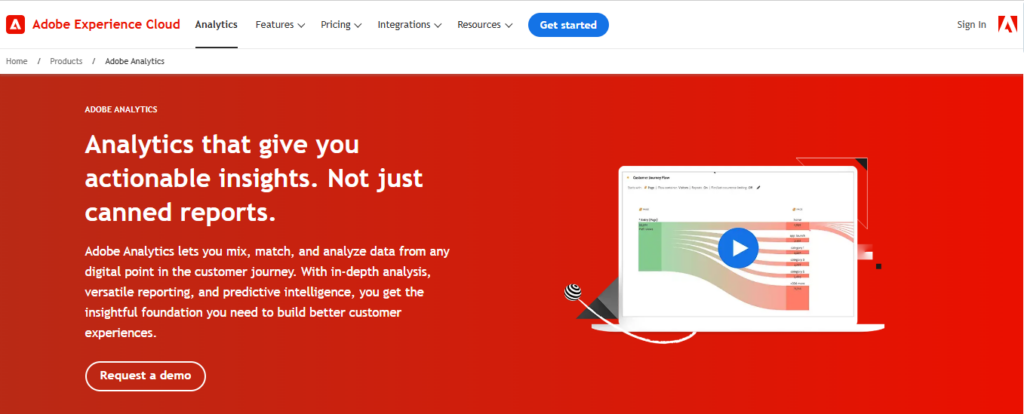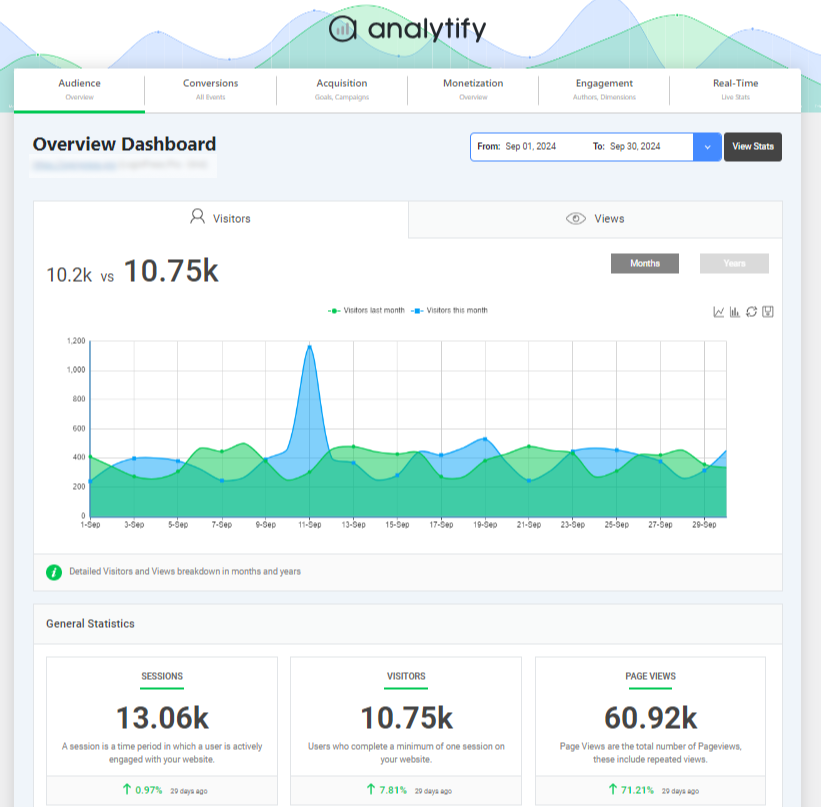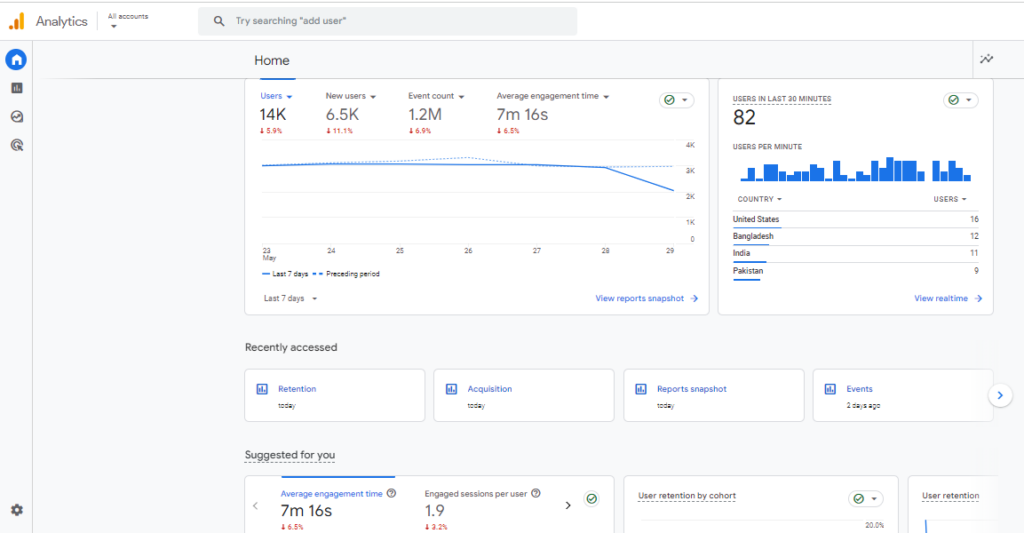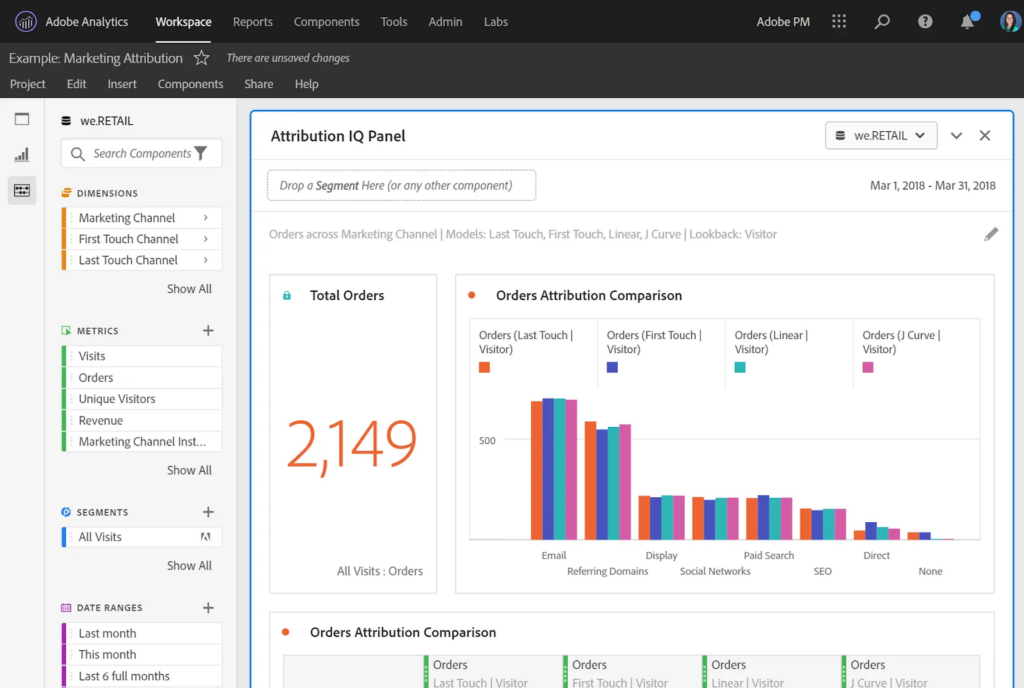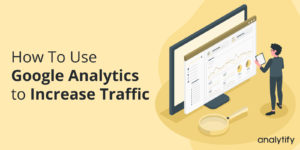
Google Analytics vs Adobe Analytics (Compared)
Are you confused about choosing Google Analytics vs Adobe Analytics as the right analytics tool?
In today’s data-driven world, where 91.9% of organizations reported achieving measurable value from their data and analytics investments, choosing the right web analytics tool is more critical than ever.
In this comprehensive guide, we’ll break down everything you need to know about Google Analytics vs Adobe Analytics to help you make the correct choice.
Whether you’re a small business exploring budget-friendly solutions or a large enterprise looking for advanced insights, this guide will cover every aspect you should consider, including pricing, ease of use, features, and data visualization.
Google Analytics vs Adobe Analytics (TOC):
Overview of Google Analytics and Adobe Analytics
Let’s start by clarifying what each platform is designed to offer, highlighting key differences between Adobe Analytics vs Google Analytics.
Google Analytics
Google Analytics (GA) is a widely-used analytics tool, especially popular among small to medium-sized businesses and eCommerce websites. It provides insights into user behavior, traffic sources, and conversion paths, helping businesses optimize their websites for better engagement and higher conversions.
Adobe Analytics
Adobe Analytics, on the other hand, is a premium, enterprise-focused analytics tool within the Adobe Experience Cloud. It’s designed for large-scale data analysis, offering advanced segmentation, cross-channel analysis, and customizable reports, making it a top choice for enterprises with complex data needs.
| Feature | Google Analytics | Adobe Analytics |
| Target Audience | Small to medium-sized businesses | Medium to large enterprises |
| Cost | Free (GA4), Paid (GA360) | Subscription, custom pricing |
| Focus | Web tracking, user behavior | Enterprise data analysis, advanced segmentation |
| Integrations | Google suite, other platforms | Adobe Experience Cloud, APIs |
| Complexity | Easy to Set up | High, requires setup expertise |
These key differences are just the beginning.
Before deciding between Google Analytics and Adobe Analytics, it’s helpful to first understand how Google Analytics works. Learn the fundamentals of GA4 here.
In the following sections, we’ll take a closer look at Google Analytics vs Adobe Analytics pricing models, starting with how they compare on costs.
Pricing Comparison: Google Analytics vs Adobe Analytics
Pricing is among the first factors most businesses consider when choosing an analytics platform. Here’s how Google Analytics vs Adobe Analytics stack up when it comes to cost and value.
Adobe vs. Google Analytics Pricing Models
| Feature | Google Analytics Price | Adobe Analytics Price |
| Free Version Available | Yes (GA4) | No |
| Enterprise Option | Yes (GA360, paid) | Yes (subscription, custom pricing) |
| Typical Starting Cost | $0 for GA4, $150,000 for GA360 | Starting around $100,000+ |
| Best Fit | Small to medium businesses | Enterprises needing detailed data |
| Integration Value | Strong with the Google ecosystem | Strong with Adobe Experience Cloud |
Google Analytics offers both free and paid plans, while Adobe Analytics is entirely premium. Read more about Google Analytics 4 paid plan pricing in this article.
Which Platform Offers Better Value?
- Small Businesses and Startups: Google Analytics, with its free option, is the best choice for small companies or businesses testing analytics for the first time. The free features in GA4 are generally sufficient for tracking site traffic, user behavior, and conversions.
You can also explore Analytify, which acts as a bridge between the raw data of Google Analytics and your WordPress website, making it a valuable tool for businesses of all sizes that want to use analytics without the complexity.
Join 50,000+ beginners & professionals who use Analytify to simplify their Google Analytics!
- Medium to Large Enterprises: Adobe Analytics is often more attractive to larger organizations that need deeper, customizable insights, and it can justify the high price of Adobe Analytics due to its advanced capabilities.
Adobe’s subscription model may offer more flexibility and control despite its higher upfront cost for companies that require advanced support, cross-platform integration, and complex segmentation.
Ease of Setup and Implementation: Google Analytics vs. Adobe Analytics
When it comes to setting up and implementing an analytics tool, Google Analytics and Adobe Analytics have different approaches. Google Analytics is often praised for its straightforward setup, while Adobe Analytics is known for offering robust customization but with a steeper learning curve.
Google Analytics Setup
Google Analytics is generally easier to set up, especially for beginners or businesses without a dedicated analytics team. Here’s a breakdown of the setup process:
- Creating an Account and Property: Google Analytics requires users to set up a new property for each website or app they wish to track. The setup process is intuitive and provides step-by-step guidance.
- Adding Tracking Code: To start collecting data, you need to add a JavaScript tracking code (or use Google Tag Manager for ease) to your website. Plugins such as Analytify are available for WordPress, to simplify this step.
- Google Tag Manager Integration: If you want more flexibility without manually editing code, Google Tag Manager (GTM) allows you to create and manage tracking tags for multiple properties. GTM is especially useful for setting up events, conversions, and custom tracking parameters.
- Google Analytics with Analytify: While Google Analytics has a clean, user-friendly interface, it can still feel overwhelming for beginners. This is where Analytify steps in, simplifying Google Analytics data by organizing key metrics into easy-to-read reports within WordPress.
- With Analytify’s dashboard, users don’t have to leave WordPress to see important insights like page views, bounce rates, and top-performing content. This setup is beneficial for businesses without dedicated analytics experts, as it reduces the learning curve and makes data more accessible.
Here’s a screenshot of Analytify’s dashboard, showing how it visually organizes Google Analytics data for easy access:
Adobe Analytics Setup
Adobe Analytics setup is more complex and often requires a specialized team or developer support. Here are the steps and requirements for Adobe Analytics implementation:
- Provisioning Adobe Experience Cloud: Adobe Analytics is part of the Adobe Experience Cloud, so businesses need to activate their Experience Cloud account before setting it up.
- Implementing Adobe Launch (Tag Manager): Adobe Launch is Adobe’s tag management system, similar to Google Tag Manager. It enables businesses to manage tracking codes, events, and custom tags.
- Customization: Adobe Analytics provides extensive customization options but comes with added complexity. Setting up custom events, eVars (custom variables), and props (properties for tracking) requires configuration and often collaboration with IT teams.
- Data Layers: Adobe Analytics uses data layers for complex implementations, which require detailed planning and, in many cases, programming knowledge.
Comparison of Setup Complexity
| Setup Component | Google Analytics | Adobe Analytics |
| Tracking Code Setup | Simple, with step-by-step guidance | Complex requires Adobe Launch setup |
| Tag Manager | Google Tag Manager | Adobe Launch |
| Customization | Basic to Moderate | High, extensive customization |
| Required Expertise | Minimal for basic setup | High; often requires developer support |
| Time to Set Up | Quick for basic tracking | Longer, especially for advanced features |
Adobe Analytics may initially require more resources to set up, but it provides unparalleled control for businesses that need intricate data tracking. In contrast, Google Analytics’ straightforward setup is perfect for businesses that value ease of use and rapid deployment.
Features and Capabilities Comparison: Google Analytics vs Adobe Analytics
When it comes to features, Google Analytics and Adobe Analytics each offer a range of capabilities to suit different analytics needs. From tracking user behavior to creating detailed reports, both platforms have tools that can be adapted for businesses of various sizes.
Here’s a detailed comparison of Google Analytics vs Adobe Analytics core and advanced features.
Feature Comparison Table
| Feature | Google Analytics | Adobe Analytics |
| User Behavior Tracking | Events-based (page views, interactions) | Custom events with eVars, props |
| Conversion Tracking | Conversion events | Custom goal configuration |
| Cross-Channel Attribution | Limited in GA4 | Detailed, customizable models |
| Advanced Segmentation | Basic and custom audiences | Robust segmentation tools |
| Predictive Analytics | Yes, with GA4 | Yes, through Adobe Sensei |
| Custom Dashboards | Moderate customization | Highly customizable Analysis Workspace |
| Path Analysis | Limited | Advanced cohort and path analysis |
| BigQuery Integration | Available in GA360 | None, but it integrates with Adobe tools |
Which Platform Has Better Features and Capabilities?
- Small to Medium Businesses: Google Analytics offers a solid range of features, particularly with GA4, making it a good choice for organizations that need reliable analytics without extensive customization.
- Large Enterprises: Adobe Analytics provides more depth and flexibility in features. For organizations requiring cross-channel analysis, advanced segmentation, and robust custom reporting, Adobe’s features and capabilities are a better fit.
In short, Google Analytics has user-friendly, foundational tools suited for general business needs, while Adobe Analytics excels in providing highly customizable and detailed insights, ideal for complex data environments.
User Interface and Usability: Google Analytics vs. Adobe Analytics
User experience plays an important role in how effectively an analytics platform can be leveraged. Google Analytics and Adobe Analytics offer distinct interfaces designed for different user types and organizational needs. Let’s compare the user interface, usability, and learning curve of both platforms.
Google Analytics Interface
Google Analytics has a clean, user-friendly interface designed for accessibility. Here are some of the key aspects of GA’s interface:
- Dashboard Layout: The Google Analytics dashboard is organized with a left-hand navigation menu and clearly labeled sections for reports, settings, and admin tools. Most features are easy to find, making it accessible for beginners.
- Pre-built Reports: Google Analytics offers a variety of pre-built reports, covering essentials like audience demographics, acquisition sources, and conversions. These reports are easy to navigate, with a simple click-through interface.
- Customization Options: GA allows you to create custom dashboards and reports but doesn’t overwhelm users with too many options. Users can quickly add or remove widgets, change chart types, and adjust date ranges.
- Learning Curve: For most users, the learning curve is manageable. GA provides many online resources, including Google Analytics Academy, which offers free courses to help users get started and understand advanced features.
- Google Analytics Dashboards on WordPress:
Adobe Analytics Interface
Adobe Analytics is designed with enterprise needs in mind, offering a more customizable but complex interface:
- Dashboard Layout: The Adobe Analytics interface is packed with features. Unlike Google Analytics, Adobe uses a workspace format called Analysis Workspace, where users can create custom dashboards and complex reports from scratch.
- Customizable Workspaces: Adobe’s Analysis Workspace is highly flexible, allowing users to build entirely customized reports by dragging and dropping dimensions, metrics, segments, and time periods. This is especially useful for businesses with unique tracking needs.
- Advanced Visualization Tools: Adobe Analytics offers a wider variety of visualization options than GA, including freeform tables, cohort tables, and anomaly detection. This is ideal for users who need a deep dive into data trends and patterns.
- Learning Curve: Adobe Analytics requires more time and expertise to master. Due to its extensive customization capabilities, new users may find it challenging. Adobe offers learning resources, but many companies opt for in-house training or hire analytics experts to manage their Adobe setup.
Comparison Table: Reporting and Visualization
| Feature | Google Analytics | Adobe Analytics |
| Standard Reports | Yes, pre-built | Limited; encourages custom reports |
| Custom Dashboards | Yes, with basic widgets | Yes, highly customizable |
| Visualization Options | Basic (line, bar, pie charts) | Advanced (flow, cohort tables, anomalies) |
| Analysis Tools | Exploration reports | Analysis Workspace with multi-dimensional views |
| Predictive Analytics | Basic in GA4 | Advanced with Adobe Sensei |
| Data Studio Integration | Yes, for more complex visuals | No direct equivalent; custom options |
| Collaboration and Sharing | Limited | Extensive, with live links and shared projects |
In short, Google Analytics offers a more straightforward experience that is ideal for quick insights and standard reports. At the same time, Adobe Analytics is designed for enterprises that require customized, in-depth analysis.
Data Collection and Processing: Google Analytics vs Adobe Analytics
Data collection and processing lie at the core of both Google Analytics and Adobe Analytics. Each platform has its approach to gathering, organizing, and processing data, directly impacting the type of insights you can derive.
Here’s how Google Analytics vs Adobe Analytics compares in terms of data collection and processing capabilities.
Comparison Table of Data Collection and Processing
| Feature | Google Analytics | Adobe Analytics |
| Tracking Model | Event-based (GA4) | Event-based with custom variables (eVars, props) |
| Automatic Tracking | Yes, via Enhanced Measurement | No, it requires a custom setup |
| Cross-Device Tracking | Limited, through Google Signals | Strong, with ECID for cross-channel tracking |
| Data Layers | No | Yes, for detailed tracking |
| Real-Time Processing | Yes | Yes, with batch-processing options |
| Privacy Compliance Features | IP anonymization, user consent tools | Data retention control, compliance tools |
Ultimately, Adobe Analytics provides more control and precision in data collection, while Google Analytics offers a more straightforward, user-friendly approach with automatic event tracking. The choice depends on your organization’s data complexity and compliance requirements.
Mobile Analytics and App Tracking: Google Analytics vs Adobe Analytics
As mobile usage continues to rise, tracking app performance and user behavior on mobile devices is essential for businesses. Both Google Analytics and Adobe Analytics offer mobile tracking capabilities, but they approach it differently.
Here’s how Google Analytics vs Adobe Analytics compares in terms of mobile analytics and app tracking.
Google Analytics Mobile and App Tracking
Google Analytics, particularly in its GA4 version, offers strong support for mobile app tracking through Firebase, Google’s app development platform.
| Metric | Description |
| Screen Views | Number of times app screens are viewed |
| In-App Purchases | Revenue generated from purchases within the app |
| Session Duration | The average time users spend in each session |
| User Demographics | Age, gender, and location of app users |
| Crash Analytics | Reports on app crashes and technical issues |
Adobe Analytics Mobile and App Tracking
Adobe Analytics provides a highly customizable approach to mobile tracking with its Adobe Mobile SDK, offering granular data collection for app interactions and user behavior:
| Metric | Description |
| Unique User Sessions | Total unique sessions on the app |
| App Retention Rate | Percentage of users who return to the app |
| In-App Purchases | Revenue from transactions within the app |
| Push Notification Opens | Number of times users open the app from notifications |
| Custom User Segments | Segments defined by custom attributes or behaviors |
So, Google Analytics is ideal for basic mobile analytics, while Adobe Analytics excels in customization and cross-device analysis, making it better suited for complex, enterprise-level mobile apps.
Also, Just like Google Analytics vs. Adobe Analytics, it’s essential to compare Google Search Console and Google Analytics to see which tool fits your tracking needs. Read about the key differences between Google Search Console and Google Analytics 4 to enhance your website’s performance tracking.
Pros and Cons: Google Analytics vs Adobe Analytics
After a detailed exploration of each feature and capability, let’s take a step back and look at the overall strengths and limitations of Google Analytics and Adobe Analytics.
This pros and cons summary table will help you quickly evaluate each platform and determine which one best aligns with your business goals.
Pros and Cons of Google Analytics
| Pros | Cons |
| Free option available: GA4 is free, making it accessible for small to medium businesses. | Limited customization: While flexible, GA4 doesn’t offer the same level of customization as Adobe Analytics. |
| Easy to set up and use: GA4 is user-friendly, has a straightforward setup process, and is ideal for teams without technical expertise. | Limited advanced features: Predictive analytics and custom metrics are more limited compared to Adobe’s offerings. |
| Seamless Google ecosystem integration: Integrates easily with Google Ads, Search Console, BigQuery, and other Google tools. | Privacy limitations: Google Signals and cross-device tracking rely on Google’s anonymized data, limiting detailed individual tracking. |
| Data Studio integration: Google Data Studio allows for enhanced visual reporting and combines data from multiple sources. | No native CRM integration: Integrates with CRMs via third-party tools, which may require extra setup. |
| Predictive insights available: GA4 includes predictive metrics, providing insights into user behavior like purchase probability. | GA360 cost: For enterprises, Google Analytics 360 is a costly upgrade, around $150,000 per year. |
Pros and Cons of Adobe Analytics
| Pros | Cons |
| Advanced customization: Offers powerful custom metrics (eVars and props) for detailed tracking and data segmentation. | High cost: Adobe Analytics is a premium tool with custom pricing that starts around $100,000 per year. |
| Integration with Adobe Experience Cloud: Ideal for businesses already using Adobe tools like Adobe Target, Adobe Campaign, and Adobe Audience Manager. | Steeper learning curve: Requires technical knowledge and setup, making it challenging for non-technical users. |
| Real-time data and segmentation: Adobe’s real-time tracking and segmentation make it ideal for monitoring live events and dynamic user behavior. | Lacks native integrations with Google tools: Limited direct integration with Google Ads, Search Console, etc., can be a drawback for some. |
| Advanced reporting capabilities: Adobe’s Analysis Workspace provides extensive reporting flexibility, which is ideal for enterprises with complex reporting needs. | Complex setup: Adobe Launch, eVars, and props require configuration, often needing developer assistance. |
| Cross-channel tracking: The Experience Cloud ID (ECID) provides cross-device and cross-channel tracking capabilities. | Requires in-house expertise: Most Adobe Analytics implementations benefit from dedicated analytics or IT teams to manage configurations and reporting. |
Which Platform Should You Choose?
- Choose Google Analytics if you’re a small to medium business needing a cost-effective analytics tool that’s easy to set up and integrates well with Google’s ecosystem. Google Analytics is ideal for teams looking for accessible, general insights without advanced customization.
- Choose Adobe Analytics if you’re an enterprise with complex data requirements, extensive customization needs, and the resources to invest in a premium analytics tool. Adobe’s powerful segmentation, cross-channel tracking, and integration with Adobe’s Experience Cloud make it well-suited for large organizations prioritizing detailed data insights and personalization.
FAQs about Google Analytics vs Adobe Analytics
Which is better, Adobe or Google?
It depends on your needs. Google Analytics is cost-effective and user-friendly, ideal for smaller businesses. Adobe Analytics, while pricier, offers extensive customization and advanced features suited for large enterprises.
What is the difference between GA4 and Adobe Analytics?
GA4 is event-based, free, and integrates well with Google’s tools, making it accessible for general business use. Adobe Analytics provides custom metrics and advanced segmentation, focusing on detailed data analysis for larger organizations.
What is the strongest competitor to Google Analytics?
Adobe Analytics is considered a top competitor, especially for enterprises needing more customization and advanced data handling capabilities.
Is Adobe Analytics useful?
Yes, Adobe Analytics is very useful for businesses with complex data needs. It provides deep insights, real-time segmentation, and advanced customization options.
Conclusion: Choosing Between Google Analytics vs Adobe Analytics
In choosing the right analytics tool for your business, understanding the unique strengths of Google Analytics and Adobe Analytics is essential. Each platform has its distinct advantages, catering to different types of businesses and data needs.
Google Analytics is ideal for small to medium-sized businesses or those new to analytics, with Analytify being the best choice for WordPress users for Google Analytics. On the other hand, similar to Google Analytics 360, Adobe Analytics shines in its customization and scalability, making it a better choice for large enterprises with complex data requirements.
We hope this article helped you choose the right analytics tool between Google Analytics vs Adobe Analytics.
You may also like to know about the Most Important Content Marketing Metrics and know about a comprehensive list of metrics that can be tracked using Google Analytics.
You may also like to read this comparison article on Mixpanel vs Google Analytics (Detailed Comparison).
Now, we’d like your thoughts on which analytics tool you found best for your web analytics.


